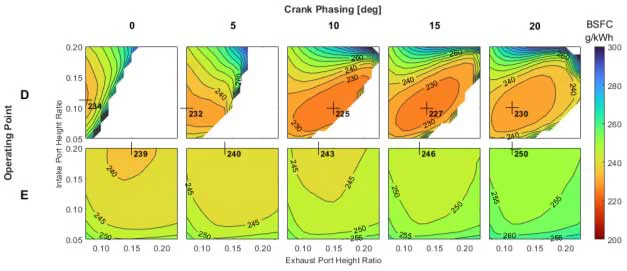Optimizing Opposed-Piston Engines for Thermal Efficiency
Posted by: Alex Young
Opposed-piston two-stroke engines reveal degrees of freedom that make them excellent candidates for the next generation of highly efficient internal combustion engines for hybrid-electric vehicles and power systems. The configuration of an opposed piston engine is shown in the first diagram where two pistons, each with a respective crankshaft, share a single cylinder. The combustion chamber is formed between the two piston crowns, removing the requirement for a cylinder head.

In his PhD research, Alex Young from the Advanced Automotive Propulsion Systems Centre for Doctoral Training (AAPS CDT) at the University of Bath investigates a novel pressure-balanced free-piston engine linear generator concept. The array of contours shown below demonstrate the effect of key engine design parameters (crankshaft phasing and intake and exhaust port height-to-stroke ratios) on fuel consumption for two different range extender operating points (D: 16 bar BMEP; E: 8 bar BMEP). So, while better fuel consumption can be achieved under higher load, the range of attainable operation is more restricted. These and other effects are explored in depth in his latest article in the journal Energies: “The Effect of Crankshaft Phasing and Port Timing Asymmetry on Opposed-Piston Engine Thermal Efficiency”, freely available at this link: https://doi.org/10.3390/en14206696

This publication was made possible thanks to funding from the EPSRC Centre for Doctoral Training in Advanced Automotive Propulsion Systems, grant number EP/S023364/1. Alex would also like to thank his co-authors Aaron Costall and Daniel Coren from Institute for Advanced Automotive Propulsion Systems at the University of Bath, and James Turner from CCRC at KAUST.